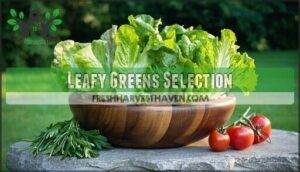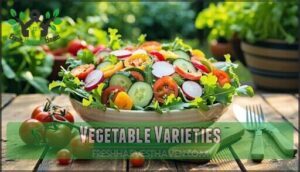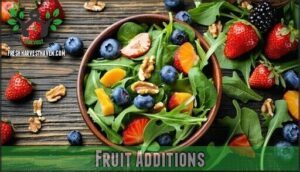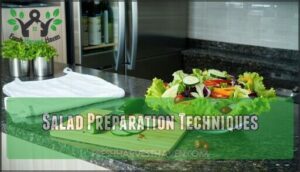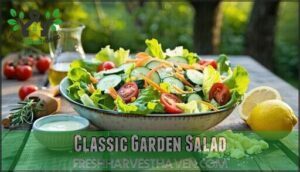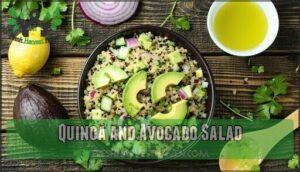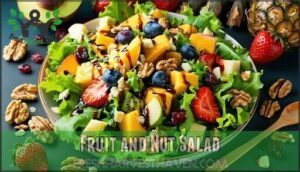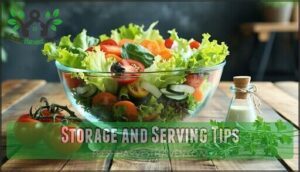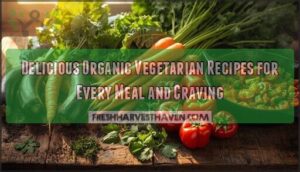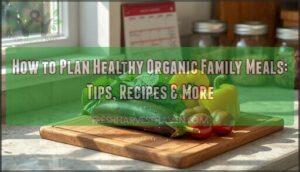This site is supported by our readers. We may earn a commission, at no cost to you, if you purchase through links.

Start with fresh greens like romaine or spinach, then add colorful vegetables, proteins, and homemade dressings.
I’ve found that washing greens ahead saves precious time during busy weeknights.
Mix textures with crunchy cucumbers, creamy avocado, and tangy tomatoes.
The secret isn’t complicated—it’s about balancing flavors and keeping ingredients prepped.
Whether you’re craving a classic mix or something with quinoa and nuts, these recipes work with whatever’s in your fridge.
The real game-changer comes down to mastering just a few simple techniques, which involves balancing flavors and keeping ingredients prepped, to create a satisfying meal.
Table Of Contents
- Key Takeaways
- Garden Salad Basics
- Choosing Fresh Ingredients
- Salad Preparation Techniques
- Quick Garden Salad Recipes
- Storage and Serving Tips
- Frequently Asked Questions (FAQs)
- How do you make a simple garden salad?
- What is the difference between a green salad and a garden salad?
- What is normally in a garden salad?
- How to make simple vegetable salad?
- What is easy fresh garden salad?
- What is a garden salad?
- How long does it take to make a garden salad?
- How do you make a healthy garden salad?
- What can I use to make a garden salad?
- What goes well with a garden salad?
- Conclusion
Key Takeaways
- You’ll save time by washing and prepping greens ahead of busy weeknights, keeping them crisp in airtight containers with paper towels for up to three days.
- You can transform any basic salad by mixing textures and flavors – combine crunchy cucumbers, creamy avocado, tangy tomatoes, and proteins like grilled chicken or chickpeas.
- You’ll create better dressings using the golden ratio of one part vinegar to three parts oil, adding them just before serving to prevent wilting.
- You’ll build satisfying 15-minute meals by keeping core ingredients stocked – romaine lettuce, cherry tomatoes, cucumbers, carrots, and red onions form your reliable foundation.
Garden Salad Basics
You’ll discover that garden salads become your go-to meal when you understand the basics of fresh ingredients and simple preparation methods.
These versatile dishes offer endless customization options while delivering essential nutrients and keeping your grocery budget in check, making them a great choice for a healthy and affordable meal with simple preparation.
Essential Ingredients
When building your garden salad recipe foundation, think of these essential ingredients as your flavor starting lineup. Each vegetable brings its own personality to the mix, from crisp lettuce varieties to juicy fresh vegetables that make every bite count.
Here’s what you’ll need for the perfect base:
- Lettuce types: Romaine for crunch, iceberg for mildness, or mixed greens for variety
- Tomato choices: Cherry tomatoes for sweetness or beefsteak for bold flavor
- Cucumber crunch: English or Persian varieties add invigorating texture
- Onion flavors: Red onions bring sharpness while green onions offer gentle bite
- Carrot prep: Grated or julienned carrots provide natural sweetness and color
These core vegetables create your tomato cucumber salad foundation, letting you whip up a satisfying meal in just minutes.
Customization Options
With your garden salad foundation in place, you can transform any basic bowl into something special that matches your personal preference.
Think of salad customization as your kitchen playground—there’s no wrong way to make it yours.
Here’s how to customize your garden salad recipe:
- Protein Choices – Toss in grilled chicken, hard-boiled eggs, chickpeas, or leftover steak
- Dressing Variety – Mix up ranch, balsamic vinaigrette, or lemon-olive oil combinations
- Seasonal Produce – Add summer peaches, fall apples, or winter citrus segments
- Flavor Combinations – Balance sweet dried cranberries with salty feta and crunchy walnuts
- Dietary Needs – Skip cheese for vegan meals or add extra nuts for keto requirements
Recipe customization means you’ll never get bored with the same old salad again.
For a complete meal, consider adding protein sources.
Health Benefits
With just one bowl, you’re getting amazing nutrient density from leafy greens packed with vitamins A, C, and folate.
The fiber content keeps you satisfied longer while supporting smooth digestion—like having a personal health coach in your kitchen.
Regular salad eaters often meet more daily vitamin intake needs and enjoy disease prevention benefits that reduce chronic illness risks.
Leafy greens also provide essential minerals such as calcium and potassium.
These healthy salad recipes with fresh vegetables deliver serious nutritional benefits without breaking your calorie count.
It’s healthy eating made simple and delicious.
Cost-Effective
Beyond the nutritional perks, you’ll love how budget-friendly these easy salad recipes can be.
Smart shopping transforms fresh vegetables into wallet-friendly meals that don’t sacrifice flavor.
Smart shopping transforms fresh vegetables into wallet-friendly meals that don’t sacrifice flavor.
Here’s your money-saving playbook:
- Budget vegetables like carrots and cabbage stretch your dollar while adding serious crunch to any garden salad recipe
- Seasonal savings happen when you shop what’s abundant—think tomatoes in summer, squash in fall
- DIY dressings using pantry staples cost pennies compared to store-bought bottles
- Bulk buying nuts and seeds, then freezing extras, gives you quick salad ideas without breaking the bank
Homegrown produce takes cost-effective to the next level, delivering the freshest ingredients right from your backyard.
Choosing Fresh Ingredients
You’ll get the best garden salad when you pick ingredients that look bright and feel firm at the grocery store.
Fresh greens should snap when you bend them, and tomatoes need to give slightly when you press them but not feel mushy.
Leafy Greens Selection
Your salad foundation matters most—choose fresh greens with crisp leaves and no browning edges.
Fresh greens with crisp leaves are your salad’s secret to restaurant-quality crunch every time.
I’ve found mixing lettuce types creates better flavor pairings: butter lettuce adds sweetness while arugula brings peppery heat.
Organic options work best since conventional spinach contains more pesticides.
Different lettuce variety choices offer unique nutrient profiles—red leaf lettuce provides more antioxidants than iceberg.
Proper washing methods keep your leafy greens lasting longer in the fridge.
Consider seasonal salad ingredients for ideal taste and health benefits.
Vegetable Varieties
You’ll find that crisp vegetables transform any salad from boring to brilliant.
These fresh vegetables pack serious crunch and nutrients that make every bite satisfying.
Here are my go-to vegetable varieties for quick salads:
- Heirloom Tomatoes – cherry or grape varieties burst with sweetness
- Root Vegetables – shredded carrots and thinly sliced radishes add pepper and color
- Crisp Vegetables – cucumbers and bell peppers deliver that satisfying crunch
- Exotic Greens – try arugula or watercress mixed with your usual lettuce
Smart vegetable preparation saves time.
I’ve learned that seasonal harvests taste better and cost less.
During seasonal vegetables peaks, stock up on what’s fresh.
Your salad becomes more exciting when you mix textures and flavors thoughtfully.
Understanding seasonal vegetable options can help you create more varied and delicious salads.
Fruit Additions
Adding fresh fruit to your garden salad opens up a world of Berry Options like blueberries and blackberries that pair beautifully with mixed greens.
Citrus Fruits such as orange segments brighten any strawberry spinach salad, while Tropical Fruits like mango create vibrant combinations.
Try Stone Fruits including peaches in summer or Dried Fruits for year-round sweetness.
These additions transform simple greens into exciting meals like apple walnut salad or pomegranate kale salad—even spicy mango jicama salad becomes possible with creative fruit and nut salad combinations.
Nuts and Seeds
Nuts and seeds transform any garden salad recipe into a powerhouse meal. I’ve tested countless combinations, and these additions deliver serious Crunchy Textures while boosting Nut Nutrition. Seed Benefits include healthy fats and protein for your healthy lunch ideas.
Here’s my go-to list for quick salad recipes:
- Almonds: Sliced or whole, perfect crunch factor
- Sunflower seeds: Budget-friendly with nutty flavor
- Walnuts: Heart-healthy omega-3s, slightly bitter edge
- Pumpkin seeds: Protein powerhouse, naturally salty
- Cashews: Creamy texture, mild sweetness
For Nut Allergies, sunflower seeds work perfectly. Proper Seed Storage keeps them fresh longer—airtight containers prevent rancidity.
Salad Preparation Techniques
You’ll master these salad prep techniques in minutes, and trust me, proper washing and drying makes all the difference between a soggy mess and restaurant-quality crunch.
Once you’ve got the chopping rhythm down, you can whip up fresh salads faster than ordering takeout.
Chopping and Washing
Once you’ve picked your fresh ingredients, it’s time to master the prep work that’ll make or break your garden salad recipe.
Sharp knife skills make vegetable prep a breeze. Start your washing tips routine by rinsing leafy greens in cold water to remove dirt and pesticides.
Use consistent chopping techniques for even pieces. Your vegetable washing routine should include a thorough rinse in a colander. A salad spinner transforms soggy leaves into crisp perfection for salad preparation success. Effective salad chopper tools can greatly simplify the chopping process.
Drying and Storage
Your salad spinner becomes your kitchen’s best friend for vegetable drying and moisture control. After washing greens, spin them dry or gently pat with paper towels to preserve that satisfying crunch.
Smart leaf storage keeps your crisp lettuce fresh for days:
- Store washed greens in airtight containers with paper towels
- Keep salad components separate until serving time
- Layer delicate leaves between towels for maximum fresh keeping
This simple moisture control method transforms soggy disappointments into restaurant-quality salads every time. Effective salad spinner use is key to achieving the best results, ensuring a great salad experience.
Dressing Preparation
Your perfectly dried greens deserve better than bottled dressing. Vinaigrette making starts with the golden dressing ratio: one part vinegar to three parts oil. I’ve tested countless combinations, and this formula never fails.
Oil selection matters more than you’d think. Extra virgin olive oil brings robust flavor, while neutral oils like canola let other ingredients shine. For vinegar types, apple cider adds sweetness, while red wine vinegar packs a punch.
Here’s my foolproof method for homemade salad dressing:
- Combine vinegar and oil in a mason jar
- Add pinch of salt and pepper
- Include teaspoon of Dijon mustard as emulsifier
- Shake vigorously for thirty seconds
- Taste and adjust flavor enhancement with herbs or honey
This simple salad dressing beats store-bought every time. Using a vinaigrette maker can also help create perfect emulsions.
Tossing and Serving
Once you’ve mastered dressing preparation, tossing tips become your secret weapon. Add dressing right before serving to maintain crisp lettuce. Use salad tongs or two large spoons—never forks that bruise greens.
Understanding spring salad essentials is vital for creating a delicious and fresh garden salad.
| Tossing Tips | Serving Styles | Plating Ideas |
|---|---|---|
| Gentle circular motions | Family-style bowl | Individual glass bowls |
| Bottom-up folding | Buffet station | Layered mason jars |
| Light hand pressure | Plated portions | Wooden serving boards |
| Even distribution | Side salads | Garnished presentations |
Perfect salad presentation means dressing timing matters most—wilted greens kill any meal’s vibe.
Quick Garden Salad Recipes
You’ll love how these quick garden salad recipes turn simple vegetables into satisfying meals in just 15 minutes.
From classic combinations to creative twists with grilled chicken, quinoa, or fresh fruits, you can customize each recipe to match what’s in your fridge right now, using simple vegetables.
Classic Garden Salad
Since mastering Salad Basics starts with this timeless classic garden salad recipe, you’ll discover why it’s the foundation every home cook needs.
This fresh garden salad combines crisp romaine lettuce with vibrant cherry tomatoes, cool cucumber slices, and shredded carrots for natural sweetness.
- Fresh Ingredients tip: Choose firm romaine hearts over bagged lettuce for better crunch and longer storage
- Garden Tips: Slice vegetables uniformly so each bite delivers balanced flavors and textures
- Meal Prep hack: Prep vegetables separately and store in glass containers to maintain crispness for three days
A simple vinaigrette using olive oil and lemon juice lets your Fresh Ingredients shine without masking their natural flavors.
This easy salad recipe proves that simplicity wins every time.
Grilled Chicken Salad
Chicken breast becomes the star when you marinate it in olive oil, garlic, and herbs for thirty minutes.
Grill at medium-high heat until it reaches 165°F—about twelve minutes per side.
While it rests, toss romaine with cherry tomatoes, cucumber, and red onion. Grilled veggies like corn and bell peppers add smoky flavor.
Slice the chicken breast and layer over greens with avocado, feta, and your favorite salad toppings.
This grilled chicken salad delivers thirty grams of protein per serving.
Quinoa and Avocado Salad
Quinoa and avocado salad combines complete Protein Sources with Healthy Fats for a satisfying vegetarian salad.
This quick recipe takes fifteen minutes using pre-cooked quinoa.
The Quinoa Benefits include all nine essential amino acids, while Avocado Nutrition provides heart-healthy monounsaturated fats.
Add avocado last to prevent browning.
- Mix quinoa with diced cucumber and red onion for crunch
- Whisk lemon juice with olive oil for simple Salad Dressings
- Store components separately for superior fresh ingredients quality
Fruit and Nut Salad
Sweet meets nutritious when you create this fruit and nut salad. Start with mixed greens, then add chopped apples, strawberries, and dried cranberries for natural sweetness. Toss in walnuts for protein and crunch. A blueberry vinaigrette ties everything together beautifully.
| Tropical Fruits | Nutty Delights | Seed Options |
|---|---|---|
| Pineapple chunks | Pecans | Sunflower seeds |
| Mango slices | Almonds | Pumpkin seeds |
| Kiwi pieces | Cashews | Chia seeds |
| Orange segments | Pine nuts | Flax seeds |
This healthy garden salad adapts perfectly to seasonal fruit combinations, making it your go-to summer salad recipe for any vegetarian salad craving.
Storage and Serving Tips
You’ll love how simple tricks can keep your garden salads crisp and fresh for days.
The secret is storing greens properly and adding dressings at the right moment to avoid soggy disappointment.
Keeping Greens Fresh
Why do your greens turn into sad, wilted mush overnight? Fresh handling and proper salad preservation techniques make all the difference. I’ve learned through countless recipe tests that crisp lettuce needs tender loving care to maintain that perfect crunch.
Here’s your green storage game plan:
- Wash thoroughly – Rinse leafy greens in cold water, removing dirt and grit completely
- Spin dry completely – Use a salad spinner for wilt prevention; excess moisture kills crunch
- Line containers – Place paper towels in airtight containers for crunch maintenance
- Store properly – Keep in crisper drawers where humidity stays controlled for ideal leafy care
Dressing Storage
Your crisp greens need equally fresh dressings. Here’s what I’ve learned after countless salad experiments: homemade dressings last up to one week in your fridge when stored properly.
Use airtight containers or mason jars for your homemade vinaigrette – they’re game-changers. Don’t worry when oil-based dressings separate; it’s normal. Just shake before using.
Smart storage methods include keeping fresh herbs and garlic separate until serving time. Add them last for maximum flavor punch. Label containers with dates – trust me, you’ll forget when you made that amazing lemon vinaigrette.
Refrigeration techniques matter too. Store creamy dressings on upper shelves where temperatures stay consistent. Your dressing storage system will transform your salad storage routine completely.
To preserve the flavor and potency of your herbs, understanding proper drying methods is essential for the best results.
Serving Suggestions
Your garden salad deserves better than basic serving suggestions. Create salad bars with colorful toppings for crowdpleasing gatherings.
Plating ideas matter—use white dishes to showcase vibrant vegetables. Portion control becomes easier with smaller bowls.
Big batch salad works perfectly for parties when you separate wet ingredients. Food presentation improves with herb garnishes.
Meal timing tip: serve immediately after dressing to maintain crispness and avoid soggy disappointment.
Meal Prep Ideas
The smartest meal prep strategy is creating a salad assembly line that keeps everything fresh.
I’ve learned from countless weeks of soggy disasters that proper meal planning transforms your kitchen game completely.
Here’s my foolproof batch cooking system for makeahead salad success:
- Jar Salads: Layer dressing first, then hardy vegetables, proteins, and greens on top for perfect portion control
- Fresh Ingredients Storage: Keep soft items like tomatoes separate in airtight containers with paper towels
- Quick Recipes Prep: Pre-chop sturdy vegetables on Sunday for five-minute garden salad recipe assembly
- Food Storage Mastery: Use divided containers to prevent cross-contamination and maintain crispness
This meal prep approach guarantees restaurant-quality salads all week long.
Frequently Asked Questions (FAQs)
How do you make a simple garden salad?
Looking for fresh crunch in minutes?
Start with chopped romaine lettuce as your base.
Add diced tomatoes, cucumber slices, and shredded carrots.
Toss with your favorite dressing just before serving to keep everything crisp.
What is the difference between a green salad and a garden salad?
Green salads typically contain just leafy greens and simple dressing, while garden salads include mixed vegetables like tomatoes, cucumbers, carrots, and onions alongside the lettuce base.
What is normally in a garden salad?
You’ll find crisp lettuce, fresh tomatoes, cucumbers, carrots, and onions forming the foundation. Many include bell peppers, celery, and radishes for extra crunch and color variety.
How to make simple vegetable salad?
Most families waste 30% of fresh produce, but you won’t with this simple approach.
Chop romaine lettuce, add cherry tomatoes, cucumber slices, and shredded carrots.
Toss with olive oil and vinegar just before serving to keep everything crisp.
What is easy fresh garden salad?
An easy fresh garden salad combines crisp romaine lettuce, cherry tomatoes, cucumber slices, and shredded carrots.
You’ll toss everything together, add your favorite dressing right before serving, and enjoy this simple, nutritious meal in minutes.
What is a garden salad?
A garden salad is your go-to mix of fresh lettuce, tomatoes, cucumbers, carrots, and onions. You’ll toss these crisp veggies together for a simple, healthy side dish.
How long does it take to make a garden salad?
Like assembling ingredients for a quick feast, you’ll spend just 10-15 minutes creating your garden salad. Wash, chop, and toss your veggies together – it’s faster than you’d think!
How do you make a healthy garden salad?
Start with fresh lettuce like romaine or mixed greens.
Add colorful vegetables—tomatoes, cucumbers, carrots, and bell peppers.
Choose lean proteins like grilled chicken or chickpeas.
Finish with light vinaigrette instead of creamy dressing.
What can I use to make a garden salad?
Most home cooks don’t know that you’ll use roughly 6-8 cups of mixed greens for four servings.
You can grab romaine lettuce, cherry tomatoes, cucumbers, carrots, and red onions as your base ingredients for any garden salad.
What goes well with a garden salad?
You’ll want proteins like grilled chicken, shrimp, or hard-boiled eggs to make it filling. Add cheese, nuts, seeds, or avocado for richness. Croutons provide satisfying crunch alongside your fresh vegetables.
Conclusion
Before telephones made communication instant, folks gathered ingredients from their own gardens for fresh meals.
You’ve mastered these quick garden salad recipes now, so trust your taste buds when switching ingredients.
Try maple syrup instead of honey in dressings, or swap arugula for spinach when you’re feeling adventurous.
Keep prepped vegetables in your fridge for those hectic weeknights.
These simple techniques turn any combination of fresh ingredients into satisfying fifteen-minute meals that’ll become your go-to dinner solution.

